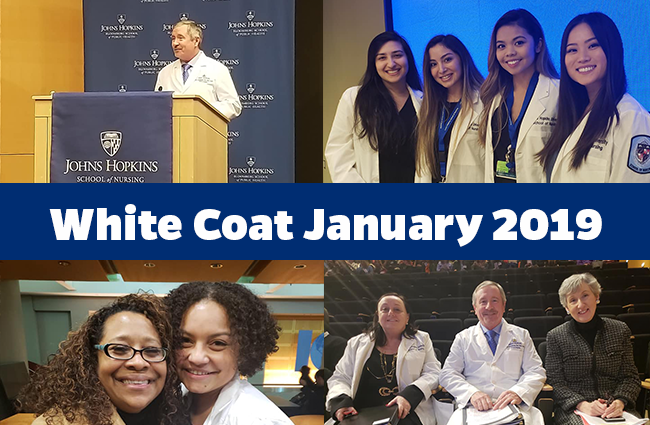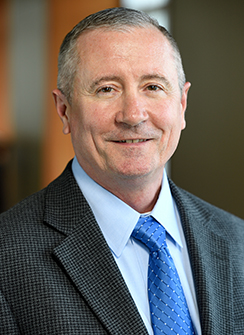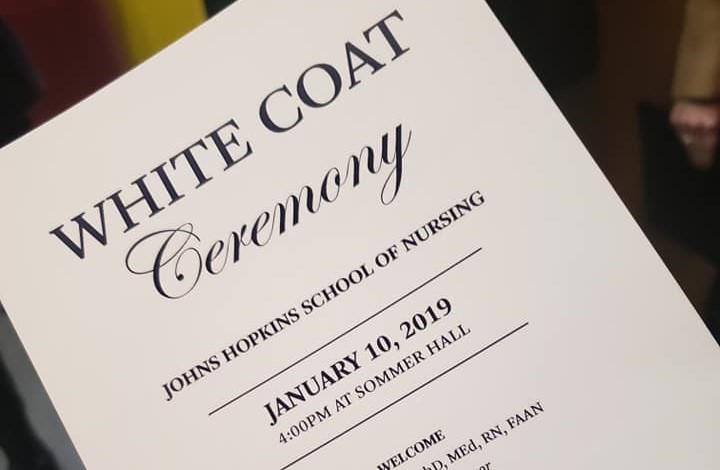Dr. Bruce Schoneboom delivered this speech on January 10, 2019 at the white coat ceremony of the Spring 2019 cohort of MSN (Entry Into Nursing) students. He was the keynote speaker of the ceremony.

Photos from the January 2019 White Coat Ceremony
Welcome to all of the incoming students, as well as the families and friends who are joining us in support as you begin your nursing journey. The future is here, you are the future! Our job as faculty is to make sure you are well prepared.
I must say I am so excited for each and every one of you. I came to the Johns Hopkins School of Nursing with a different perspective than you; I am here as a new faculty member and Associate Dean for Practice, Innovation, and Leadership. If you would have told me when I started my journey in nursing that one day I would wind up at the number one nursing school in the country, I would have called you crazy.
I can only imagine your excitement in starting your nursing career here. The education you receive here will open doors that you can only imagine. But imagination is key; if you keep an open mind, an adventurous spirit, and focus on your patients, the sky is the limit.
Dean Davidson asked me to talk about interprofessional education and advocacy in health care. So let me start with a rhetorical question. If patients and the health care system expect physicians, nurses, dentists and others to work in teams, why on earth would we educate you in silos?
Even here at Hopkins silos exist. For example, the schools of medicine, public health, and nursing all have their own unique buildings. Imagine if the schools were combined into one physical space where students and faculty could actually learn together, and even more importantly, learn about each other.
Interprofessional education is the opposite of learning in silos. So what exactly is it and how long have we been at this?
The World Health Organization defines it as “students from two or more professions learning about, from, and with each other to enable effective collaboration and improve health outcomes.” Interprofessional education is about improving the quality of care patients receive. And fundamentally it’s about teamwork. The WHO further defines it as “the levels of cooperation, coordination, and collaboration characterizing the relationships between professions in delivering patient-centered care.”
And we’ve been at it a long time! In 1972, 120 leaders from allied health, dentistry, medicine, nursing, and pharmacy considered key questions about interprofessional education at the first IOM Conference, “Interrelationships of Educational Programs for Health Professionals.” They produced one of the first IOM reports, “Educating for the Health Team” (IOM, 1972). Their recommendations stressed the importance of engaging in interdisciplinary education, the value of clinical settings for developing interdisciplinary education, and the need for governmental and professional support of interdisciplinary education for health care delivery teams.
Here’s an example of how interprofessional education works in practice. I am a Certified Registered Nurse Anesthetist (CRNA). In the operating room, team work is key and the roles change throughout the day. During the induction and emergence phase while the airway is at risk, the CRNA is in charge, during the operation, the surgeon is in charge, and during other times, like when the operating room nurse is counting sponges and needles, the nurse is in charge. And we all know as part of this team how to lead and when to follow.
I was deployed to Afghanistan in 2006 as part of a forward surgical team. There were about 60 of us, surgeons, nurses, and other health professionals. We were strangers from all over the country who showed up to Fort Benning, Georgia a few weeks before Christmas. At that time the Army sent medical personnel to Georgia to train up as a team before deploying to facilities all over the world. We spent a month training together and performing mass casualty exercises so that we could build the team.
Individually we were all A+’s but together we started as an A- or a B+ because we were not a team. We learned, as I say, “When to contribute and when to execute!”
I had the privilege of a lifetime leading a group of soldiers as the commander of that team. Yes that’s right, I was a nurse and I was in command, leading surgeons, nurses, and medics into combat to care for the most vulnerable of all patients, the wounded on the battlefield.
Now just a few words about advocacy. You are entering into the most trusted profession in the United States. In a 2018 Gallop poll, Americans ranked nurses highest for their honesty and ethics for the 17th consecutive year.
This is incredible, but it will require advocacy to stay here. Advocate for you patients, first and foremost, and advocate for your profession. A Hopkins nurse is like no other, and when much is given, much is expected in return. You, as part of the Johns Hopkins School of Nursing, will define the future of nursing. That is a big charge, but I am confident that all of us together can continue in the footsteps of the giants who walked these halls before us. As I told Dean Davidson, we’re celebrating 130 years of Hopkins nursing, let’s create a legacy that we will talk about 130 years from now.
MSN (Entry Into Nursing) Program

ABOUT THE AUTHOR: Bruce Schoneboom, PhD, MHS, CRNA, FAAN,
Bruce Schoneboom is a retired Colonel is the inaugural associate dean for practice, innovation and leadership. He will advance collaborations with the Johns Hopkins Health System, particularly in anesthesiology, pain management, and global surgery, and expand practice innovation and leadership within JHSON’s Doctor of Nursing Practice Program. With the Army, Dr. Schoneboom cared for patients in West Germany, joined the Army’s nurse anesthesia program, and earned his PhD in neuroscience from the Uniformed Services University of the Health Sciences. He commanded al surgical hospital on the Afghanistan-Pakistan border in 2006 where he cared for soldiers and provided humanitarian help to local nationals. He currently serves on the U.S. Department of Health and Human Services (HHS) National Advisory Council for Nursing Education and Practice and the HHS Inter-Agency Pain Management Best Practices Task Force.
